Name Egill Skallagrimsson Role Poet | Children Thorgerd Egilsdottir | |
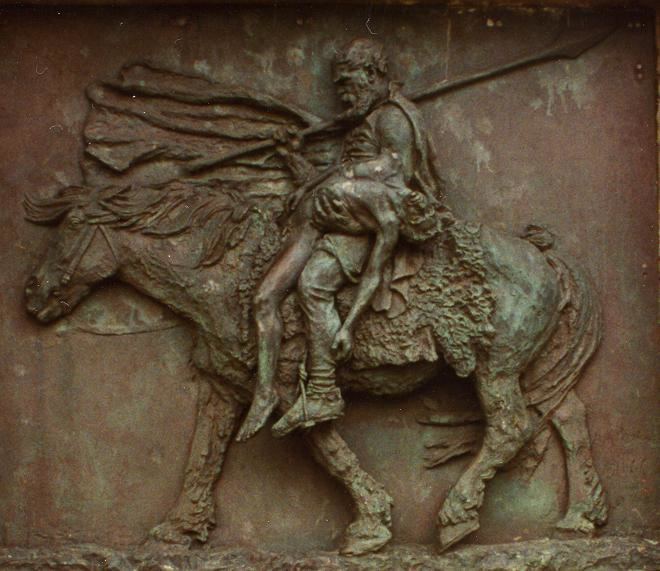 | ||
People also search for Olvir Hnufa, Thorgerd Egilsdottir, Eyvind Lambi | ||
Egill Skallagrímsson: The Warrior Poet (Viking History Explained)
Egill Skallagrímsson (c. 904 – c. 995) was a Viking-Age poet, warrior and farmer. He is also the protagonist of the eponymous Egil's Saga. Egil's Saga historically narrates a period from approximately 850 to 1000 CE and is believed to have been written between 1220 and 1240 CE.
Contents
- Egill Skallagrmsson The Warrior Poet Viking History Explained
- Egill Skallagrmsson pt 1
- Life
- Issue
- Poems
- Runes
- Egill in popular culture
- References

Egill Skallagrímsson, pt. 1
Life
The following is based on the Icelandic saga "Egil's saga"; like many sagas, it can be unreliable as a source of historical fact.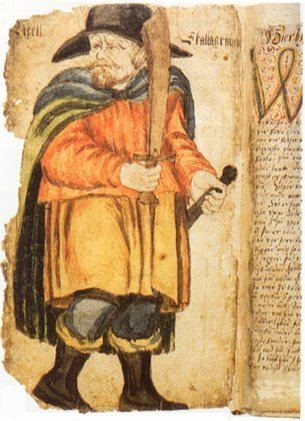
Egill was born in Iceland, the son of Skalla-Grímr Kveldúlfsson and Bera Yngvarsdóttir, and the grandson of Kveld-Úlfr ("Night Wolf"). His ancestor, Hallbjorn, was Norwegian-Sami.
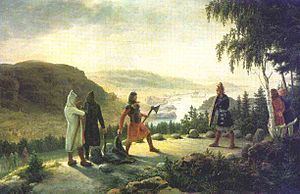
When Grímr arrived in Iceland, he settled at Borg, the place where his father's coffin landed. Grímr was a respected chieftain and mortal enemy of King Harald Fairhair of Norway.
Egill composed his first poem at the age of three years. He exhibited berserk behaviour, and this, together with the description of his large and unattractive head, has led to the theory that he might have suffered from Paget's disease. As professor Byock explains in his Scientific American article, Paget's disease causes a thickening of the bones and may lead eventually to blindness. The poetry of Egill contains clues to Paget's disease, and this is the first application of science, with the exclusion of archaeology, to the Icelandic sagas.
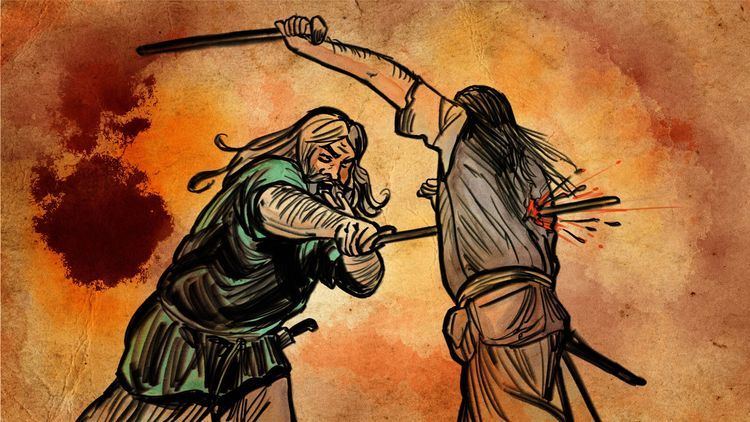
At the age of seven, Egill was cheated in a game with local boys. Enraged, he went home and procured an axe, and returning to the boys, split the skull to the teeth of the boy who cheated him. After Berg-Önundr refused to allow Egill to claim his wife Ásgerðr's share of her father's inheritance, he challenged Önundr to a man-to-man fight on an island or holmgang.
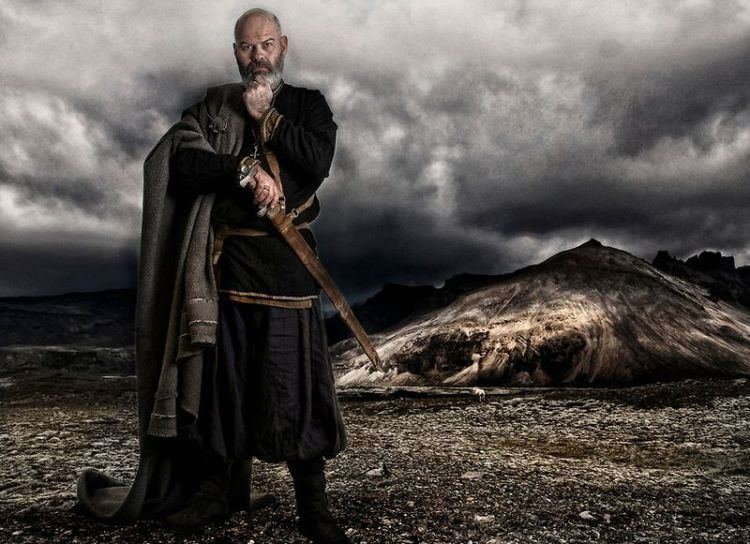
Later, after being grievously insulted, Egill killed Bárðr of Atley, a retainer of King Eirik Bloodaxe and kinsman of Queen Gunnhildr, both of whom spent the remainder of their lives trying to take vengeance. Seething with hatred, Gunnhildr ordered her two brothers to assassinate Egill and his brother Þórólfr, who had been on good terms with her previously. However, Egill slew the Queen's brothers when they attempted to confront him. Gunnbildr's brother's names were Eyvind Braggart and Alf Aksmann.
In spring Þórólfr and Egill got ready a large warship and went the Eastern route (Austrvegr), where they won much wealth and had many battles. In Courland they made a peace for half a month and traded with the men of the land. (ch. 46).
That same summer, Harald Fairhair died. In order to secure his place as sole King of Norway, Eirik Bloodaxe murdered his two brothers. He then declared Egill an outlaw in Norway. Berg-Önundr gathered a company of men to capture Egill, but was killed in his attempt to do so. Before escaping from Norway, Egill also slew Rögnvaldr, the son of King Eirik and Queen Gunnhildr. He then cursed the King and Queen, setting a horse's head on a Nithing pole and saying,
"Here I set up a níð-pole, and declare this níð against King Eiríkr and Queen Gunnhildr,"—he turned the horse-head to face the mainland—"I declare this níð at the land-spirits there, and the land itself, so that all will fare astray, not to hold nor find their places, not until they wreak King Eiríkr and Gunnhildr from the land." He set up the pole of níð in the cliff-face and left it standing; he faced the horse's eyes on the land, and he carved runes upon the pole, and said all the formal words of the curse. (ch. 57).Gunnhildr also put a spell on Egill, which made him feel restless and depressed until they met again.
Soon afterwards, Eiríkr and Gunnhildr were forced to flee to the Kingdom of Northumbria by Prince Hákon. In Saxon England, they were set up as King and Queen of Northumbria in rivalry with King Athelstan of England. Ultimately, Egill was shipwrecked in Northumbria and came to know who ruled the land. Egill sought out the house of his good friend Arinbjorn where they armed themselves and marched to Eiríkr's court. Arinbjorn told Egill “now you must go and offer the king your head and embrace his foot. I will present your case to him.” Arinbjorn presented Egill’s case and Egill composed a short drápa, reciting it with Eirikr’s foot in his hand, but Eirikr was not impressed. He explained that Egill’s wrongs to him were far too great to be forgiven so easily. Gunnhild called for the immediate execution of Egill, but Arinbjorn convinced the king not to kill him until the morning.
The Vikings deemed it illegal to kill a man during the night time. Arinbjorn told Egill that he should stay up all night and compose a mighty head-ransom poem or drápa fit for such a king, a poem in praise of his enemy. In the morning Egill went before king Eirik Bloodaxe and recited the great drápa. This twenty-stanza long head-ransom poem appears in Chapter 63 of "Egil's saga". Eirik was so surprised by the quality of the poem that he generously decided to give Egill his life, even though he had killed his own son. The complex nature of these poems with unique word order determined by sophisticated word choice and metaphor or kenning, as explained in the Poetic Edda, as well as the fact that they were often about Kings and recited first in their royal presence ensures that seeds of history abide in them, and the fact that professor Byock could diagnose Paget's disease from such poetry adds credence to the truthfulness of their content. Such complex poems were remembered entirely, as a whole cloth, or not at all. "Egil's saga" and other Icelandic sagas appear to hang on a skeletal framework of such complex poetry, a spine of historical truth.
Egill also fought at the Battle of Brunanburh in the service of King Athelstan, for which he received payment in silver.
Ultimately, Egill returned to his family farm in Iceland, where he remained a power to be reckoned with in local politics. He lived into his eighties and died shortly before the Christianisation of Iceland. Before Egill died he buried his silver treasure near Mosfellsbær. In his last act of violence he murdered the servant who helped him bury his treasure.
When a Christian chapel was constructed at the family homestead, Egill's body was re-exumed by his son and re-buried near the altar. According to the saga, the exhumed skull bone was hit with an axe, and it only turned white, showing the strength of the warrior, but also suggesting the traits of Paget's disease.
Issue
Egill had five children with Ásgerðr Björnsdóttir: Þorgerðr Egilsdóttir, Bera Egilsdóttir, Böðvar Egilsson, Gunnar Egilsson and Þorsteinn Egilsson. In later years, Iceland's Myrar clan claimed descent from him.
Poems
Apart from being a warrior of immense might in literary sources, Egill is also celebrated for his poetry, considered by many historians to be the finest of the ancient Scandinavian poets and Sonatorrek, the dirge over his own sons, has been called "the birth of Nordic personal lyric poetry". His poems were also the first Old Norse verses to use end rhyme. The following works are attributed to Egill:
- Aðalsteinsdrápa. Drápa for the Anglo-Saxon King Æthelstan.
- Höfuðlausn ("The Head Ransom", sometimes referred to as "Head-Ransom"), with which Egill bought his life from Eiríkr Bloodaxe, who had sentenced him to death in England.
- Sonatorrek ("The Loss of a Son"). After the death of his son Böðvar who drowned during a storm.
- Arinbjarnarkviða. Dedicated to his companion Arinbjörn
- Skjaldardrápa.
- Berudrápa.
- Lausavísur.
- Fragments
The following is one of Egill's Lausavísur (no. 3), found in chapter 40 of Egils Saga:
Runes
Egill was also a scholar of runes. His apparent mastery of their magic powers assisted him several times during his journeys. During a feast at Atla-isle, Bard's attempt to poison Egill failed when a rune carved by Egill shattered his poisoned cup.
At a companion's request, he examined a sick woman. A local land owner, after being denied her hand in marriage, had attempted to carve love-runes. Instead, he had mistakenly carved runes causing illness. Egill burned the offending runes and carved runes for health, and the woman recovered. He then sang a poem declaring that "Runes none should grave ever/Who knows not to read them."
Both these incidents are quite believable. Most poisons of the period were strong alkaloids which would cause cow-horn drinking cups to fray. This was one reason for their use. When Egill carved the rune, in all likelihood he had spotted the fraying (which he would have been looking for) and used it to disguise why he pried at the cup.
As for the sick young woman, in addition to burning the runes, Egill ordered her to be lifted out of bed and her old bedding to be thrown away and replaced with new sheets. Recovery was swift.
Runes were also employed by Egill during the raising of the Nithing Pole against King Eirik Bloodaxe and Queen Gunnhildr.
